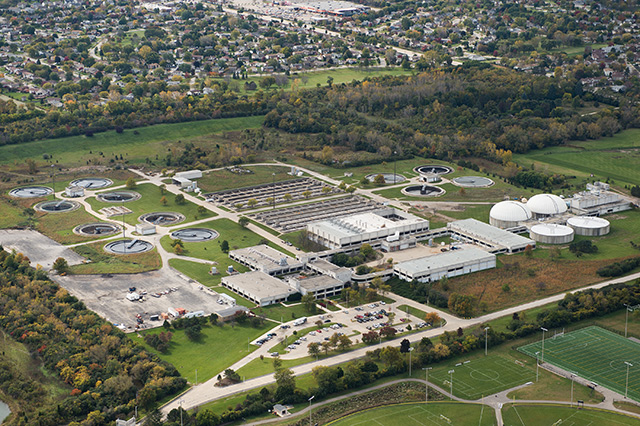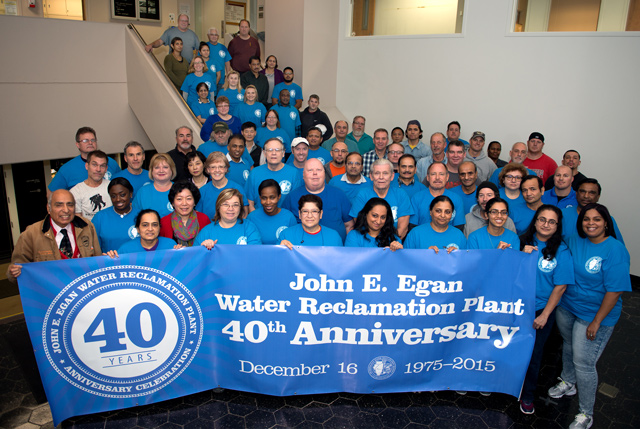John E. Egan WRP

Celebrating its 40th anniversary in 2015, the MWRD's John E. Egan Water Reclamation Plant (WRP) in Schaumburg exemplifies a major advance in the art and science of wastewater treatment. The Egan WRP incorporates a novel two-stage secondary process as well as an advanced tertiary system for the removal of water-borne pollutants. It has a design capacity of treating 50 million gallons of water per day (mgd).
Only seven years after it came into service, the United States Environmental Protection Agency selected the Egan WRP the "best operated and maintained" large plant in Region V. The Egan WRP grounds are extensively landscaped to create a pleasant garden-like atmosphere, which emphasizes the relationship between the facility and the natural environment.
Wastewater entering Egan WRP passes through coarse screens to filter out large debris, followed by pumping and primary settling, which includes further screening, grit removal and separation of solids from the water in which aerated grit tanks and settling tanks remove fats and oils. In secondary treatment, microorganisms remove organic material from the water as oxygen is pumped into aeration tanks. Solids then settle at the bottom and clean water flows out the top of additional settling tanks. Water is then disinfected through a tertiary process that uses chlorination and dechlorination. Filters made of sand and anthracite continue polishing the solids before the clean water is released from the Egan WRP into Upper Salt Creek. After only 7.8 hours, the wastewater is transformed from sewage to clean water.
The Egan WRP is in the process of developing groundbreaking technology
that will remove ammonia during the water treatment process, lessening
the impact of nitrogen and phosphorus on local waterways and exceeding
current standards. The ANITA™ Mox process is specially developed for treatment of streams
highly loaded in ammonia, such as centrate, the water remaining after
removal of solids at Egan. Egan WRP treats the solids from the Egan (50
mgd) and Kirie (30 mgd) plants. Because of process
limitations, the centrate has been diverted from Egan to the O’Brien WRP,
roughly 15 miles away, exacerbating odor and corrosion in the collection
system. The Anita Mox process, being constructed using existing tanks,
will allow centrate treatment on-site at Egan in an energy-efficient
manner.
The ANITA Mox process is designed to achieve ammonia removal higher than 90 percent and total nitrogen removal in the range of 75 to 85 percent without external carbon addition and at a very low energy cost compared to conventional nitrification-denitrification. Utilizing Moving Bed Biofilm Reactor (MBBR) technology, the single-stage nitrogen removal process will lower the plant’s carbon footprint. The project aims to reduce oxygen consumption by 60 percent, eliminate all chemical oxygen demand, decrease carbon dioxide emissions, reduce sludge production and lessen the amount of nitrogen returning to the plant headwork.
Energy efficient nitrogen removal is the next step in the evolution of wastewater treatment. The process is critical because excess nitrogen discharged to waterways can contribute to water quality problems, and traditional removal of nitrogen from wastewater is energy intensive and costly. Following a successful cooperative pilot project at the Egan WRP and in Denver, Colo., the MWRD is moving forward to install Anita Mox.
This process is a step towards the MWRD’s goal of development of the deammonification technology for mainstream application. If successful, this process will conservatively reduce energy usage by 40 percent, saving 120 million kilowatt per hour annually, the equivalent energy provided by 15 utility-scale wind turbines or enough energy for 4,500 homes.
In its pursuit of energy neutrality, the MWRD also installed a solar thermal system to convert solar heat into useable hot water at Egan. The MWRD has installed 45 solar panels, donated by the city of Chicago, through an intergovernmental agreement, and installed with grant assistance from the Illinois Department of Commerce and Economic Opportunity. These panels generate 2,040 therms annually. The system provides preheated boiler make-up water, hot water for solids treatment and other hot water needs at the plant. The benefits are:
-
Lowers natural and digester gas usage in the steam boiler system. This saves non-renewable energy usage and cost.
-
Serves as a demonstration of this technology for possible use in other applications at the MWRD.
-
Reduces emission of greenhouse gases and pollutants.
-
Lowers the impact of future energy price fluctuations on the MWRD.
As part of the water treatment process, the MWRD also recently upgraded a dewatering facility at Egan WRP to provide increased storage capacity for biosolids, add a close conveyance system to address odors and improve the system’s reliability. Egan WRP continuously works to improve efficiency by automating chemical intensive processes like disinfection and sludge thickening as well as lowering energy usage in secondary treatment.
In conjunction with the agency’s goals of implementing green infrastructure to meet increasing demands for stormwater management, the MWRD plans to replace the parking lot at Egan WRP with new permeable pavement to provide several benefits. The new lot will improve water quality, ground water recharge and delayed discharge of stormwater to the receiving waterway. The new design will also contribute toward compliance with the green infrastructure program requirements of the National Pollutant Discharge Elimination System Permits Consent Decree.
To learn more about Egan WRP, visit here.
To read about Egan WRP's recent 40th anniversary, visit here.

Staff at the Egan Water Reclamation Plant celebrated 40 years of service in December 2015.
| National Association of Clean Water Agencies | |
|
2018 |
Platinum Award for 100% for more than 5 years with National Pollutant Discharge Elimination System Effluent Standards. |
|
2017 |
Gold Award for 100% Compliance with National Pollutant Discharge Elimination System Effluent Standards. |
|
2016 |
Gold Award for 100% Compliance with National Pollutant Discharge Elimination System Effluent Standards. |
|
2015 |
Gold Award for 100% Compliance with National Pollutant Discharge Elimination System Effluent Standards. |
|
2014 |
Gold Award for 100% Compliance with National Pollutant Discharge Elimination System Effluent Standards. |
|
2013 |
Silver Award for 99.96% Compliance with National Pollutant Discharge Elimination System Effluent Standards. |
|
2012 |
Silver Award for 99.8% Compliance with National Pollutant Discharge Elimination System Effluent Standards. |
|
2011 |
Silver Award for 99.96% Compliance with National Pollutant Discharge Elimination System Effluent Standards. |
|
2010 |
Platinum Award for 100% Compliance with National Pollutant Discharge Elimination System Effluent Standards. |
|
2009 |
Platinum Award for 100% Compliance for more than 5 years with National Pollutant Discharge Elimination System Effluent Standards. |
|
2008 |
Gold Award for 100% Compliance with National Pollutant Discharge Elimination System Effluent Standards. |
|
2007 |
Gold Award for 100% Compliance with National Pollutant Discharge Elimination System Effluent Standards. |